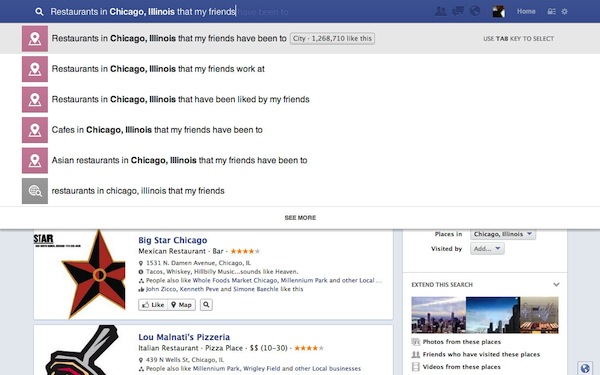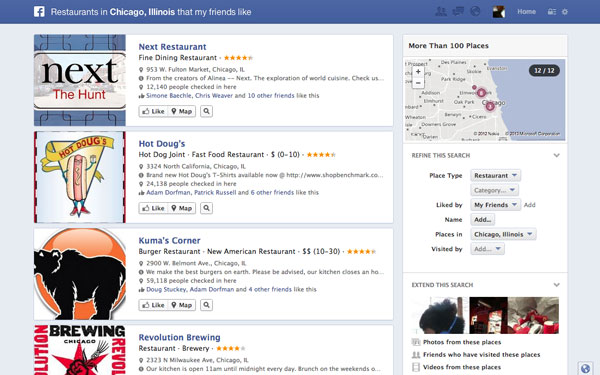Local marketing has grown increasingly important in recent years with the proliferation of smartphones, tablets, GPS, and other mobile navigation-enabled devices.
When people on the go search for businesses, they typically need directions to the nearest locations, phone numbers and other details, increasing the importance of data availability and accuracy.
As if local marketers and multi-location brands weren’t already struggling to make this information accurate, available and accessible, Facebook upped the stakes yet again with Graph Search.
Facebook’s Graph Search has already sparked an extraordinary level of interest and media coverage, because it stands a good chance of being the first true disruptor of traditional search behaviors.
Traditional search engines return relevant content from the entire web; Facebook’s Graph Search returns highly personalized content from the searcher’s own personal network (social graph).
By tapping into a searcher’s social graph, Facebook searches for people, photos, video pages, places, etc.; anything shared publicly or shared with the person conducting the search on Facebook is considered.


Opportunity Awaits
This tidal shift gives local marketers, multi-location brands and the agencies, publishers, aggregators and resellers they work with a chance to climb into the driver’s seat and capitalize on this immense opportunity. To do so, they’ll need to get local by claiming a location page for each location and working with local representatives to build an engaged local fan base.
Keep in mind, local Facebook pages have the potential to outperform national brand pages in several key facets when you consider engagement on the individual fan level. A study by Mainstay Salire found that on average local Facebook pages receive five times more marketing reach and eight times more engagement per fan than do corporate brand pages.
Content from local Facebook pages reaches a higher percentage of users’ news feeds and fans are much more likely to engage with location specific content. This higher level of engagement and local relevancy also gives local pages an edge up when it comes to Graph Search.
Those who already embraced Facebook local marketing tactics to grow their local page, increase engagement and dominate users’ news feeds should be in pretty good shape, but even those starting from scratch have a great opportunity to get out in front of the pack and reap rewards. Follow these steps for Graph Search success.
Take Control
- Be sure to claim location pages on Facebook: Continue to manage the established corporate page but also build out pages for each location that tie to the corporate page. The name, category, vanity URL and information in the “about” section will help users find these pages in Graph Search.
- Ensure accuracy of location and contact information: This may seem obvious, but inaccurate or incomplete location and contact information leads to frustration for customers and potential customers trying to visit a location or speak to a customer representative.
- Merge or remove duplicate listings: Often, when customers don’t find a location page when they attempt to “check in” they will create a Place on Facebook, which are separate from pages, creating duplicate listings with potentially incorrect or incomplete location and contact information. Be sure to check for these duplicate listings and ask for them to be removed or merged with the correct page.
Engage the Customer
- Build the local fan base: Be sure to publicize newly created pages for each location and incentivize patrons to become fans of the page through Facebook-only discounts or rewards.
- Encourage customer reviews, likes and check-ins: The more likes and interactions a page receives the greater the chance it appears in Graph Search results; upon arrival ask visitors to check in to the location. Check-in rewards like coupons and giveaways encourage visitors to check in, spreading the word about the location with their network. Once the customer interaction is complete be sure to ask for a review or recommendation on the Facebook page. Retailers can easily add these requests to customer receipts while anyone with a website can add a recommendation box which ties directly to the Facebook page.
- Publish relevant local content to spark engagement: Providing customers with interesting, authentic, location-based content will go a long way toward garnering customer loyalty and repeat page interactions. Again, the more interaction a page receives the more likely it appears in Graph Search results.
Avoiding Potential Roadblocks
As with any new technology there are potential stumbling blocks for those interested in creating, maintaining and optimizing local Facebook pages for Graph Search including scalability, compliance, and resources.
Multi-location brands often lack the bandwidth to manage more than a handful of location pages at the corporate level, but handing the controls over to franchise or branch managers opens the door to inconsistent brand messaging and page post frequency issues.
Fortunately there are tools available to assist with these issues; automation technology allows a corporate marketer to manage multiple pages simultaneously while ensuring brand consistency. Often times these tools include varying levels of account access so corporate marketers can empower branch managers to provide local content while still maintaining control through an established approval process.
When evaluating the variety of tools on the market, brands should look for one that offers multi-page updating, post moderation, compliance and social analytics to measure success. Beyond this minimum standard, brands should find the tool that best suits their needs from a partner they trust.
Don’t Get Left Behind
The competition is already working to maximize their local Facebook presence; marketers who don’t keep pace run the risk of getting left behind. To ensure they’re keeping up, marketers should measure their pages’ success against those of the competition; this provides an easy way to identify page strengths and weaknesses and quickly adjust strategy if necessary.
If by chance marketers discover that the competition hasn’t taken these steps for themselves, they can take the lead. Marketers should also set page-specific goals to meet each month such as a certain number of check-ins or recommendations or increasing the number of page interactions (likes, shares, etc.) by a certain percentage each month.
On the flip side, if marketers remain inactive on this front, the consequences could be disastrous. Choosing to ignore this opportunity severely diminishes Facebook visibility as Graph Search gains momentum, because locations won’t factor into Graph Search results.
Marketers spent significant time in recent years establishing a presence with corporate Facebook pages. Some have taken the next step to capitalize on the opportunity to be more locally relevant. Graph Search shortens the timeline and raises the stakes for those who haven’t yet.

